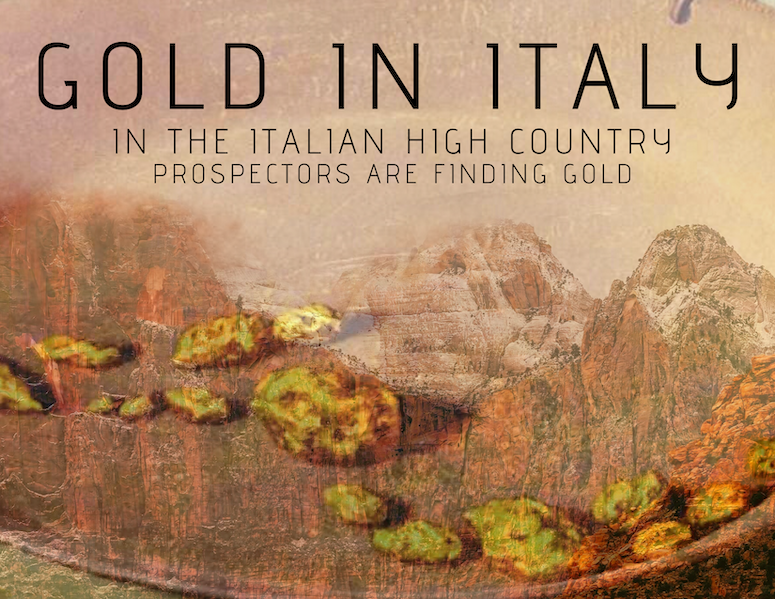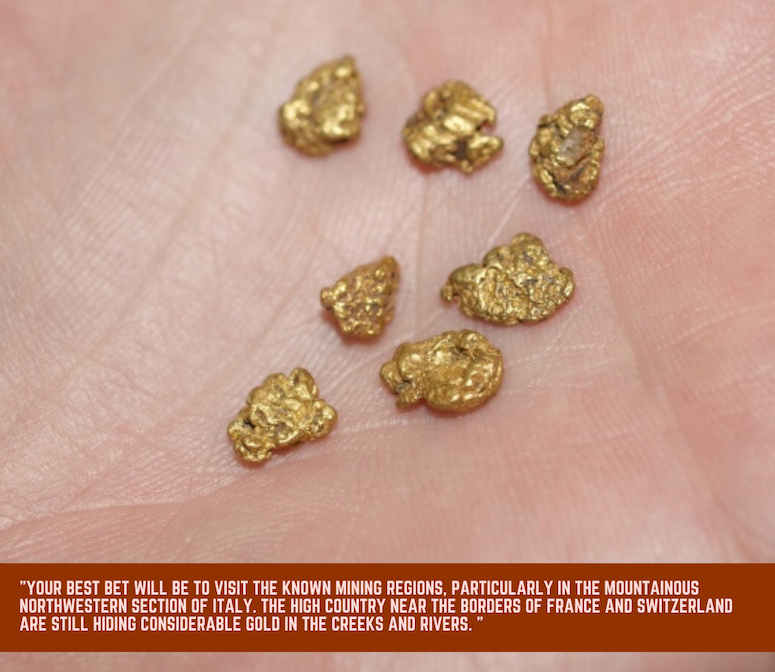
Since ancient times, gold mining in Italy has been a part of the country’s history. Large parts of the country have favorable geology that results in many gold deposits scattered throughout the creeks and rivers.
Though Italian mining has historically revolved around marble, iron, pumice and feldspar, there are a few precious patches of gold within its borders. We are going to have a look at some of the more well-known prospecting areas in this beautiful country.
Italy’s Piedmont Region
The Piedmont region of Italy has been referred to as Italy’s Klondike. With several of the Pestarena gold mines in the region producing gold since the 18th century, Piedmont has become known for its gold mining history.
Macugnaga, Brusson and Turin are all alluring gold prospecting areas within the Piedmont region. Though there is not enough gold to be had to support a full-time living wage nowadays, the landscapes in which you will find gold are worth visiting for their history and splendor alone.
Macugnaga Gold and La Citta Morta
The tiny settlement of Macugnaga hosts an underground mine known as the Guia Gold Mine. Founded in 1710, this mine remained open until after the war when production costs outweighed profit and the Guia Gold Mine was closed in 1961.
Peak production was obtained between the two world wars. The year of 1942, saw some 40,000 tons of ore pulled from the mine, producing 1,058 pounds of gold. Production increased and the year of 1948, resulted in 1,279 pounds of gold.
The gold mine is now open for guided tours and promises a glimpse of gold-bearing veins hosted in pyrite. An old mercury amalgam mill sits at its entrance.
The remnants of a mining settlement, now known as “La Citta Morta” (The Dead City), lay nearby. Arsenic deposits and old buildings have been left behind in this ghost town.
Read: Toxic Mercury & Gold Mining – How it Works (and Better Alternatives!)
Brusson’s Fenilia Gold Mine
Further south of Macugnaga is Brusson; Italian gold in this area can be found within quartz veins. The high-grade quartz samples should be crushed to produce free-milling gold for processing and removal from the host rock gneiss.
Within the Brusson area you’ll find the Fenilia Mine. It seems to go by several other names, too: Brusson Mine, Chamousira Gold Mine and La miniera di Chamousira Fenilliaz. Discovered in 1889, the Chamousira Fenilliaz Vein was most productive between 1903-1906, seeing little success after that time. Its underground expanse covers an area of 1,600 meters.
Various levels of the mine can be entered via three separate adit entrances. The Chamousira Fenilliaz Vein can be viewed on Level 7, but prospectors are not permitted to work in that area. Nearby tailing piles may produce gold that was once inaccessible when older mining technologies were used, or perhaps missed by less skillful prospectors.
Read: Nature’s Rarest Treasures – Searching for Gold Nuggets

Turin
Just south of Brusson is Turin, the capital of Italy’s Piedmont region. Gold panning near Turin and along the Po River is an ideal pastime for small-scale gold miners. The Po River basin contains gold throughout its many tributaries as well as the main river channel. Many high elevation locations are difficult to access, but they likely contain very good placer deposits.
Italy permits a great deal of freedom around hobby prospecting on public land. You can collect up to five grams of gold per day without declaring your find to authorities, which is well more than you would expect to find on the average day.
Elvo River Gold Panning
Recently, the Elvo River has drawn tourists back in with gold that was long ago deposited in the river by shrinking Alpine glaciers. Though the gold pieces are said to be “the size of breadcrumbs”, on a good day you’ll only find a bit of color in your pan.
For a bit of competition, you can register for the Italian Gold Panning Championship at the Victimula’s Gold Panner’s Arena.
The Natural Reserve of the Bessa
The Elvo River is situated parallel to an ancient open-air gold mine, the Natural Reserve of the Bessa. It was once considered the ancient world’s largest deposit of gold between the second and first century B.C. and possibly dates as far back as the 6th century B.C. Prior to gold production under the Romans, gold was mostly imported.
It is believed that the miners who worked the Bessa were primarily locals who were forced into labor under Roman occupation. Gently sloping channels were built by the workers for washing the gold and can still be seen to this day.
Read: The Ancient Roman Gold Mines in Spain

Sardinia
When compared to Australia or the United States, most of Europe has lower grade gold deposits, and Italy is no exception. Yet Sardinia does fare better than the rest of Europe, with some of the higher grade deposits running several grams of gold produced per metric ton of ore.
For thousands of years mining has been a part of the Sardinian economy, though gold mining was never prolific. When Sardinia was occupied by the Romans in 226 B.C., mining for gold became a higher priority for a time.
The very first Italian gold mine, and also the most auspicious, was established in Sardinia. Considerable gold-rich ores are present in the area, primarily along the tectonic sections where the hydrothermal alteration was most forceful. Because of this, you can expect to find epithermal gold deposits of a high sulfidation.
Furtei Gold Mine in the News
Between 1997 to 2003 the Furtei Gold Mine operated in Sardinia. But after its closure, the public was informed of some unsavory conduct on the part of the mine, including an unfixed crack in the tailings pond. Ever since, gold mining operations in the area have been stalled and the Furtei Mine is basically abandoned. Investors are hoping to manage damage at the site, nothing more.
Gold Prospecting in Italy
There are lots of tempting location for a small-scale mining adventure. With other more plentiful sources of gold drawing attention away from Italy, there is always the possibility of extracting load deposits or placer gold from more obscure areas.
If you’d like to venture out and find a little gold for yourself, there are plenty of good spots to check out. You will always have the best luck if you are close to the documented occurrences of gold. While it’s certainly possible to find gold in a completely new locations, it isn’t as likely.
Your best bet will be to visit the known mining regions, particularly in the mountainous northwestern section of Italy. The high country near the borders of France and Switzerland are still hiding considerable gold in the creeks and rivers.
Next: Gold Deposits in France’s Mountains and Rivers
